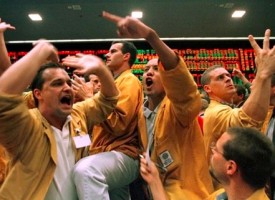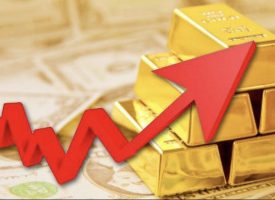As we continue trading in a very confusing time for investors in global markets, billionaire Frank Giustra warns the markets are filled with minefields at every turn, but he loves hard assets.
“In the beginning of a stock market boom it is ever the ‘dear public,’ the fleecy lambs, the most guileless victims, who make the most money. They really do not know when to stop winning, and so in the end they lose profit and principal.” — Edwin Lefèvre
Not Sure Where To Invest? There Are Minefields At Every Turn
February 3 (King World News) – Frank Giustra, billionaire businessman and global philanthropist: A crystal ball would come in handy at this moment in time. With equity markets just beginning a long overdue correction (the NASDAQ is heading toward bear market territory), true inflation soaring and geopolitical tensions rising, people are beginning to turn their full attention to their money and investments.
I am often asked for investment advice but, sadly, I do not have a crystal ball. And as I am always loath to give specific direction, I can only lay out the facts as I see them along with some probable outcomes. The problem we all face in forecasting is that we are living in truly unprecedented times with our global monetary system and debt levels, which means it is impossible to know anything with any degree of certainty. We are sailing in uncharted waters, with minefields at every turn. It’s a conundrum when deciding which assets to put your money into: no one choice feels preferable over the other.
In simple terms, the asset classes you can choose from are equities, bonds, cash, real assets and crypto. With 10,000 (and counting) cryptocurrencies with a total value over $2 trillion, it’s not hard to predict where that’s all heading. I have been saying for a long time that crypto is nothing more than a speculative bubble in desperate search of a pin. Bitcoin may survive, but as we can see from its trading pattern, it’s almost perfectly correlated with the NASDAQ and other speculative assets at a time when we have just recently entered a “risk off” environment. (Watch this for more on my thoughts on Bitcoin.)
If you believe — as I do — that we are in a long-term inflationary environment, then longer maturity bonds are the last place you want to be. Real interest rates are deep in negative territory to the tune of minus five per cent, if you use the 10-year treasury bonds as a measure. And that’s if you believe government inflation data. It’s a lot worse once you realize where true inflation really sits…
To learn which company billionaire Eric Sprott bought a
large stake in click here or on the image below

Buying bonds virtually guarantees you will lose money in real terms. Having said that, if, as I predict, the Federal Reserve starts aggressively printing money again, bonds may rally. Watch bonds closely, though. They are the best indicator of future Fed policy. I strongly believe the bond market is telling us that they don’t believe the Fed wants to raise rates or unwind its bloated balance sheet. Others disagree and interpret current bond yields to mean we are heading back to a deflationary environment rather than the inflationary one we are seeing now. The truth is, with the amount of central bank intervention in the bond market, it’s impossible to know which way things will go.
I have always loved real, tangible assets such as gold, commodities and real estate. They do extremely well in an inflationary environment and generally hold their value in normal times. I have appreciated the value of real estate, long term, ever since I read Pearl S. Buck’s book “The Good Earth” in Grade 8. But if we get a severe stock market correction, a deep recession or another crisis (all very possible), it will drag real estate — which is in its own bubble — down with it. Gold is the best real asset and should be part of every portfolio, especially with real interest rates in negative territory. It has underperformed in the last 12 months relative to what inflation and negative real rates are doing. It should be higher by all measures and is likely the only asset class not in a bubble. The probability of it going higher is much better than any other asset class.
As mentioned previously, the equity markets have started their much overdue correction. Should you panic now and avoid the rush? How far down they go will largely be a function of what the Fed actually does with raising interest rates. I doubt that they can raise rates in any meaningful way, despite all their pronouncements. I have been studying Fed behaviour for over two decades and have learned not to watch their lips, but their feet instead. And if it walks like a duck …
What concerns me is that either their monetary interventions will soon lose their efficacy, or that we experience another financial crisis or some serious geopolitical event, which in turn would usher in a long secular bear market. One like we haven’t seen in decades. This generation of investors has never experienced a secular bear market. Instead, they have been conditioned to “buy the dip” and have relied on the “Fed put” to save them when markets do fall.
What does a secular bear market look like? It took 25 years for the Dow Jones to regain its 1929 highs in nominal terms. (Ten years if you include dividends, which were unusually high at the time.) Additionally, the market went down 90 per cent from its 1929 highs to its bear market bottom.
In another example, in January 1966, the Dow Jones industrial average hit a level of 990. It would continue trading in a range of roughly 600 to 1,000 over the following 17 years. It once again reached 990 in December 1982, before finally breaking out and heading higher. Much of your decision-making on whether to stay in equities or cash out will largely depend on your investment time horizon. And of course, there will always be market rallies within a secular market if you are an astute trader. But timing markets perfectly is virtually impossible in the real world. As famed investor Ray Dalio put it, “Trying to time the market is a fool’s errand. It’s harder than competing in the Olympics” His firm, Bridgewater Associates, spends hundreds of millions of dollars trying to get an edge and it’s still competitive, even for them.
Lastly, cash. Is cash “trash” or is cash “king”? This is one of the toughest ones for me to guess. The problem is that high inflation makes the value of your cash evaporate over time. But if you believe equity markets or any of the asset classes that are in a bubble are due for a big fall, you definitely want to be sitting on a pile of cash. Alas, trying to determine the timing of that market correction or crash is difficult.
So what to do in this upside-down world we are living in? Monetary policy has created not only crazy asset bubbles and high inflation, but has left us virtually nowhere to run. The Fed has forced everyone to play a form of “Squid Game” with our money.
Whatever choice you make, the chances are pretty good that you will get killed by some unforeseen event. All I can suggest is to play it safe and diversify in different classes of uncorrelated assets and, perhaps, say a few Hail Marys. For my part, that includes cash, gold, a few bonds with shorter durations and select real estate. As I have mostly exited equities (except for Canadian dividend-yielding preferred and gold mining shares), I will wait for much lower prices to re-enter. In the meantime, if anyone has a crystal ball, I’m a buyer.
To listen to Dr. Stephen Leeb discuss what is next for the gold and silver markets and much more CLICK HERE OR ON THE IMAGE BELOW.
To listen to Alasdair Macleod discuss what is next for the gold and silver markets CLICK HERE OR ON THE IMAGE BELOW.
© 2022 by King World News®. All Rights Reserved. This material may not be published, broadcast, rewritten, or redistributed. However, linking directly to the articles is permitted and encouraged.








